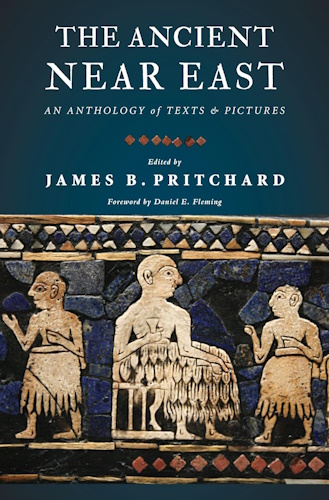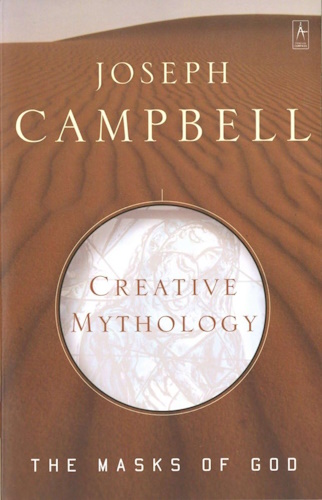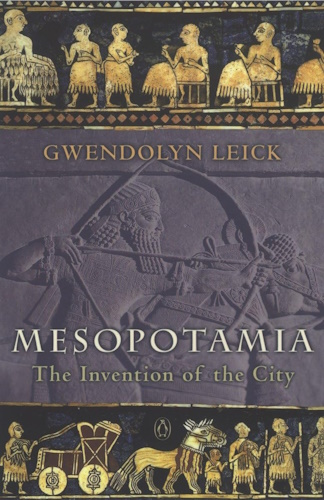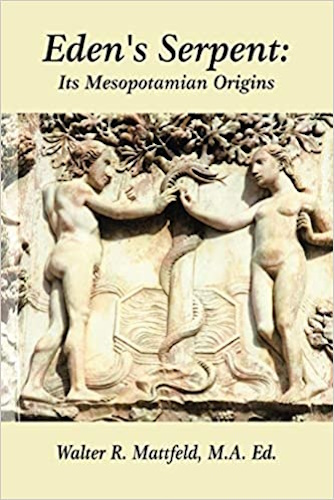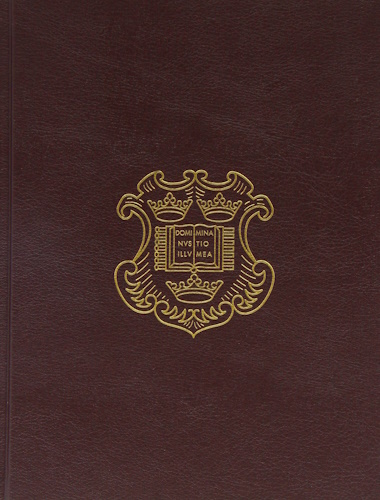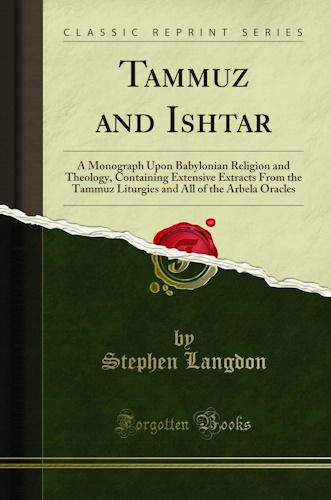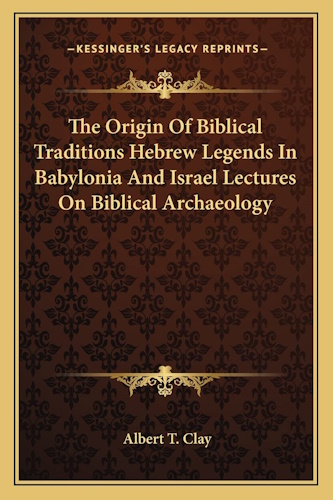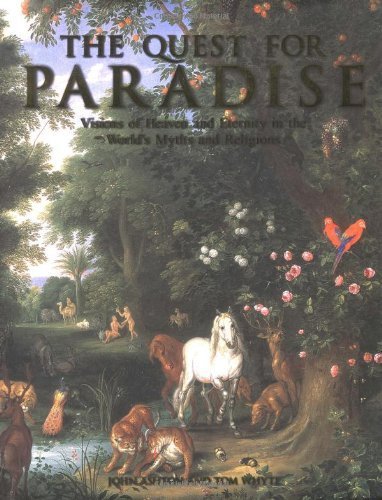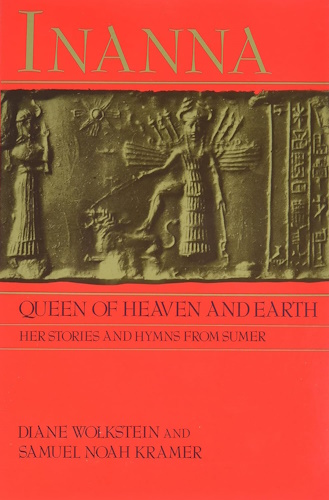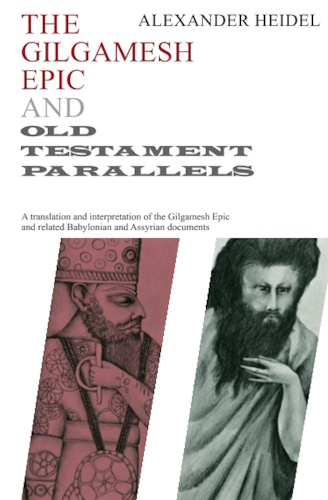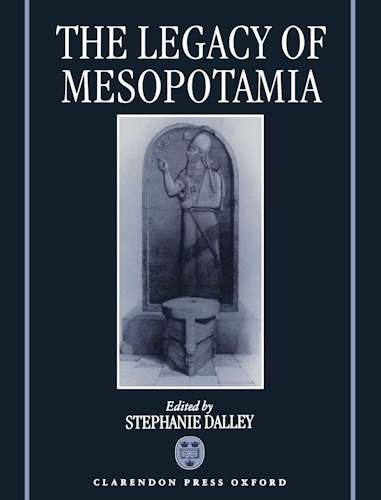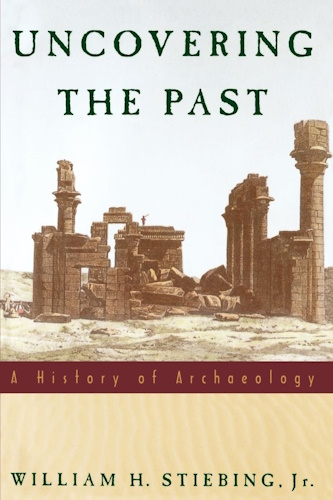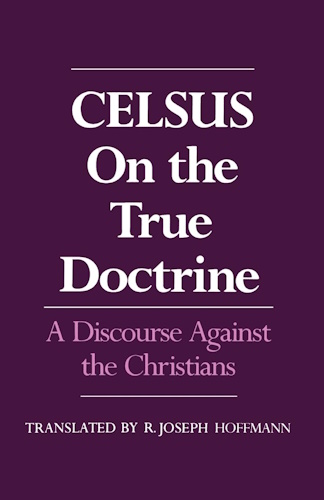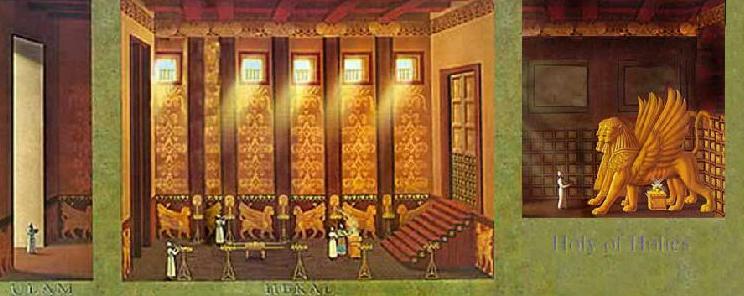![]()
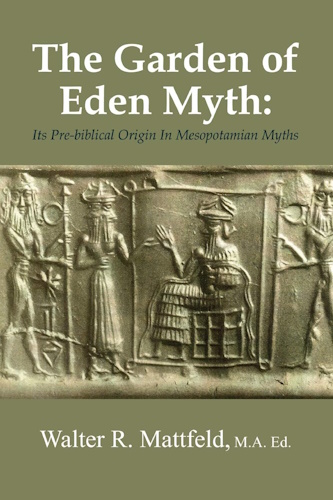
Bible Origins
The Primary History, Genesis-2Kings:
The Case for a Single Author
And Observations on The Craft
of Ancient History Writing
by
Walter Reinhold Warttig Mattfeld y d la Torre, M.A. Ed.
e-mail contact
No Date
Revisions through: 04 November 2004
![]()
A long-standing paradigm has the "Primary History" (Genesis-2 Kings) an accretion of various authors of differing ages from the days of King Solomon (or even Moses) to Ezra, the so-called JEDP theory (Jahwist-Elohist-Deuteronomist-Priestly paradigm), suggesting a "work in progress" over a period of a thousand years-
"More than a thousand years of time separate the earliest and latest compositions in the Old Testament...Probably as early as the time of David and Solomon, out of matrix of myth, legend, and history, there appeared the earliest written form of the story of the saving acts of God from Creation to the Conquest of the Promised Land...The date of the final compilation of the Pentateuch or Law...is uncertain, although some have conservatively dated it at the time of the Exile in the sixth century." (pp.xxv-xxvii. "Introduction to the Old Testament." Herbert G. May and Bruce M. Metzger, editors. The New Oxford Annotated Bible with the Apocrypha (Revised Standard Edition). New York. Oxford University Press. 1977)
An author in composing a history has to have a "grand-plan" before him, a vision of what the history will encompass. He must envision a beginning, middle and end and build his work about this frame. Such an observation was made over 2000 years ago by the Greek historian, Polybius (ca. 200-118 BCE) who wrote thusly about the "methodology" involved in composing a history-
"In their probverb 'The starting point is half the whole,' the ancients reccomended the payment of the utmost attention in any given case to the achievement of a good start; and what is commonly regarded as an exaggerated statement on their part really errs, in my opinion, by falling short of the truth. It may be asserted with confidence that the starting point is not 'half of the whole' but that it extends right to the end. It is quite impossible to make a good start in anything without, in anticipation, mentally embracing the completion of the project or realizing in what sphere and to what purpose and for what reason the action is projected. It is equally impossible adequately to summarize any given course of events without, in the process, referring to the starting point and showing whence and how and why that point has led up to the actual transactions of the moment. Starting points must accordingly be regarded as extending not merely to the middle but to the end, and the utmost attention ought, in consequence, to be paid to starting points by both writers and readers of Universal History." (p.137, Arnold J. Toynbee. Greek Historical Thought. 1952. Mentor Books [a paperback book], New American Library Publisher [originally published in the series The Library of Greek Thought by Beacon Press] citing from Polybius Book 5, chapter 31:6-33, "The Universality of History")
I find myself in full agreement with Polybius' observation, and it for this reason, that I understand that the "Primary History" (Genesis-2 Kings) is the work of a single author. Certainly he had access to and utilized earlier stories and compositions as well as traditions, but that is something that all historians do, history is not made up out of whole cloth off the top of one's head.
Noting Polybius' observation about the importance of a good beginning which must be followed through to the end, I make the following observations about the Primary History-
The history opens with the progenitors of the human race, Adam and Eve, being placed in an earthly paradise called the Garden of Eden by God. They are Condemned and "EXILED" from this paradise for failing to obey God's word. These themes, Condemnation and Exile for failing to obey God, run through the whole of the Primary History. The ending, 2 Kings 25, concludes that Israel and Judah were guilty of failing to obey God, violating his Torah, and justly condemned by Him into an EXILE from their earthly paradise, the so-called Promised Land (It is worth noting that the Prophets likened Israel to the Garden of the Lord or Eden, cf. Isa. 51:3; Ez 36:35; Joel 2:3). In summation, what happened to Adam and Eve, in the beginning, happens to Israel and Judah, in the end ---EXILE ! This over-arching theme of condemnation and allusions to an upcoming exile by Moses (De 30:1), from beginning to end, suggest this work was composed in either an Exilic or Post-Exilic world, for an audience whose personal experience of an Exile, insures that they will relate the message to their experiences.
Polybius' observations about the beginning following through to the ending seems to be in place for the Primary History, suggesting to me that this is one author's work and "grand-plan." The author of the Primary History is using a literary device called a "Ring-Composition," whereby the Beginning foreshadows the End, and the End alludes back to the Beginning. Such a device was common in Greek Histories, and apparently it was utilized by the Hebrews as well in their Primary History.
Considering that endings date beginnings in linear histories, and the fact that the Primary History is a linear history, the date of this work's composition has to be no earlier than ca. 562 BCE, when the Babylonian King, Evil Merodach came to the Throne (he reigned 562-560 BCE) and set free the Jewish king Jehoiachin (cf. 2 Kings 25:27). This history is a so-called "prose" history, it is not poetry, which was favored in earlier Epics. It is of note that the earliest Greek "prose" histories are dated to ca. 550 BCE, about the time frame of the Primary History.
Hornblower on the earliest Greek "Prose" historian, Hecateus of Ionia (flourished ca. 500 BCE) :
"Hecataeus of Miletus, the first true Greek historian: he wrote a PROSE work on genealogy, as well as a description of the world known to him, and a work on mythology. His younger critic and improver was Herodotus..."
(p.714, "Historiography, Greek." Simon Hornblower and Antony Spawforth, editors. The Oxford Classical Dictionary. 3rd edition. New York. Oxford University Press. 1996)
My research suggests that the Primary History is no later than the 562-560 BCE ending date (cf. 2 Kings 25:27). The narrator is apparently unaware of kings who succeeded Evil-Merodach, who ruled ca. 562-560 BCE, in other words, the Primary History (Genesis- 2 Kings) is probably a composition of the Exile, ca. 562-560 BCE.
If Professor Wiseman is correct in asserting that the Jewish king Jehoiachin was set free by Evil-Merodach on 24 March of 560 BCE and Jorn Barger is correct in asserting that Evil-Merodach's successor, Nergal-shar-usur, came to the throne on 13 August 560 BCE, then this would suggest that within this time frame Genesis-Kings was composed by one author.
Update 10 Feb. 2003
Professor Akenson, employing differing methodologies from my own (above), has also argued that the Primary History (Genesis- 2 Kings) is the work of one author, in the Exile.
Akenson (Emphasis is mine) :
"The arguments here are extremely simple. (1) The first nine books of the Hebrew Bible (using the Jewish, not the Christian arrangement of the scriptures, and ignoring the early medieval division of both Samuel and Kings into double volumes) are a unified invention. (2) The form of the great invention was historical writing. Mostly, its formation involved using pieces that were already available, but had not previously been fully integrated into an integral unit. (3) This unified composition, in its final form, was the product of a single great mind (however much help he may have received from his colleagues), a combination of great editor and great writer...if, as I have argued, the Genesis-Kings text is a unity, indeed the primary unity of the Hebrew scriptures, and if one accepts that the final portions of that unity (which are stylistically integrated with what comes before, and are not just a late add-on), contain a knowledge of the destruction of Solomon's Temple and of the Babylonian exile, then it is clear that Genesis-Kings in the form that we at present possess it, must be seen as an invention- a mixture of collecting and editimg old material, adding new, tossing out some items and integrating all the material that was kept- and an invention that takes place between the beginning of the Babylonian exile and before the return to the Holy Land: in other words, the middle years of the sixth century before the Common Era. This does not mean that all the investigations and speculations about earlier sources (JEDP, and so on) and about their possible dating and place of provenance are useless, but merely that they are irrelevant to the point at hand: the great moment when they were all put together in a single entity, the Genesis-Kings unity...So, what more natural- and more in tune with the primary evidence- than to suggest that it was the product of a single consciousness ? Yes, an editorial committee perhaps could have done the same job, in their collective mourning near the waters of Babylon. Yet, why posit many minds-working-as-one, when a single figure is both more economical (remember Ockham's Razor) and ultimately more convincing ?...Consider that this great act of historical writing (which later generations turned into a sacred text) was accomplished during the Babylonian exile, and probably completed about 550 BCE. The completion date is not so important (a decade earlier or later would not make any difference to the argument), but the stimulus-date, the moment when such an invention became necessary, is." (pp. 61-62. "Apparent Woe and Great Invention." Donald Harman Akenson. Surpassing Wonder, the Invention of the Bible and the Talmuds. New York. Harcourt, Brace & Co. 1998.)
"Rozenzweig is right and the reverence he suggests holds even more if one accepts the argument presented here, that not only do we receive the Hexateuch, but all of Genesis through Kings from a single hand, and, moreover, that hand was not merely a redactor, but a brilliant historical writer as well." (p.43. Akenson)
"The earliest date (the point where the last episode ends) is just that: the very first possible date of composition. Why the composition should be assumed to have occurred at the earliest date in biblical history (but not in secular history) defies explanation...Thus, I have suggested that the author-editor of the first nine books of the Genesis-Kings volumes worked in the mid-sixth century, not because Kings ends in the 560s, but because there was a social context in that period which made his work necessary for the maintenance of his own religious polity." (p.38. Akenson)
"...one has a coherent story, from creation down almost to the time of post-exilic writing and compilation, and one has a motive for the writing and editing to be done. That may be simple to state, but in historical explanations, as in mathematics, simplicity is elegance, and elegance is strength.
Acceptance of the unity of the first nine books of the Hebrew Bible, as the invention of a single religious genius (however much he may have been helped by colleagues), is dependent upon an understanding of the wonderful flexibility of the Book of Deuteronomy. It is not one thing- either the tie-up of the pre-history of the ancient Hebrews, or the beginning of what, in the context of the times, was the nation's "moder history"- it is both. The editor-cum-author here knew exactly what he was doing. The Book of Deuteronomy is a stong spine with two mighty arms. The spine and those arms can support, on the one hand the first four books of Moses, and on the other the four "Former Prophets" (Joshua, Judges, Samuel and Kings). There is a symmetry here that is immensely skilful. The four books on each hand balance each other; and each set of four becomes a set of five because they are thematically and historically integrated with the central volume, Deuteronomy." (p.27. Akenson)
Update 29 Nov. 2003
Besides Professor Akenson's above arguments for the Pentateuch being the composition of ONE author, we have also Professors Wenham and Whybray, sharing the same convictions.
Wenham on Whybray's critique of the Documentary Hypothesis (emphasis mine) :
"Whybray has two fundamental objections to the documentary hypothesis. First, it is illogical and self-contradictory and fails to explain what it professes to explain. The Pentateuch is split up into sources, because it is held that the present text contains redundant repetition and contradiction. The original sources, it is held, were noncontradictory and not repetitious, and the documentary hypothesis labors to reconstruct them on this assumption. But when the sources were linked together, a repetitious and contradictory account was produced. Why, asks Whybray, should we suppose that the methods of Hebrew writers changed so drastically ? If early writers did not tolerate contradiction or repetition, why did later writers revel in it ? But if later writers did not mind such features, why should we suppose that the earlier sources did not contain contradiction and repetition ? But if they did, how can we separate out the sources ? "Thus the hypothesis can be only maintained on the assumption that, while consistency was the hallmark of the various documents, inconsistency was the hallmark of the redactors."
Second, Whybray maintains that the phenomena of repetition and stylistic variation found in the Pentateuch, which the documentary hypothesis is alleged to explain, may be understood quite differently, as they are in other literatures. For example, since other religious texts use a variety of names for God, why should a change of divine name in Genesis signal a change of source ? Sometimes there could be a theological reason why one name is preferred to another; at others the writer may just unconsiously want a change. Repetition is often done for stylistic reasons or to emphasize something (e.g. for rhetorical effect and in poetic perallelism). It is now recognized that the study of repetition may give important insights into the meaning of the text and the skill of the author. Furthermore, Whybray holds that the attempts to describe the theology of J or E rest on too narrow a base to be convincing. But if this applies to these relatively lengthy texts, how much less plausible are the attempts of Rendtorff and Blum to define editorial layers on the basis of alleged editorial passages." (pp. 130-131. Gordon J. Wenham. "Pondering the Pentateuch: The Search for a New Paradigm." David W. Baker & Bill T. Arnold. Editors. The Face of Old Testament Studies, a Survey of Contemporary Approaches. Grand Rapids, Michigan. Baker Books. 1999. Citing R. N. Whybray. The Making of the Pentateuch: A Methodological Study. Sheffield, England. JSOT Press. 1987)
Wenham continues :
"So what does Whybray himself believe ? His agnosticism about most of the complex reconstructions of the documentary and tradition critics is manifest. He considers most of the hypotheses at best unverifiable and at worst illogical speculation...Modern literary criticism (cf. Alter and Clines) has shown that the Pentateuch is a well-constructed work, which indicates that it is the work of an author, not the end product of haphazard growth like the Midrash..."There appears to be no reason why (allowing for the possibility of a few additions) the first edition of the Pentateuch as a comprehensive work should not also have been the final edition, a work composed by a single historian"...More and more studies have been insisting on the sixth century as the time in which the whole work started to take shape...His book is a powerful and valid critique of the methods that have been taken for granted in pentateuchal criticism for nearly two centuries. Nonetheless, though I think his model for the composition of the Pentateuch is essentially correct (one major author using a variety of sources), he has not demonstrated this by giving detailed attention to the texts, nor has he shown that it was composed so late or should be regarded as fiction." (pp. 132-133. Gordon J. Wenham. "Pondering the Pentateuch: The Search for a New Paradigm." David W. Baker & Bill T. Arnold. Editors. The Face of Old Testament Studies, a Survey of Contemporary Approaches. Grand Rapids, Michigan. Baker Books. 1999)
Update 04 Nov. 2004
Professor Kitchen, a prominent Egyptologist who has written on Egypt and the Bible rejects the popular JEDP paradigm and endorses Whybray's observations on the work being by a single author :
"With the evolutionary ladder gone, what happens to the biblical literature ? Where do J, E, D, P now belong, if the old order is only a chimera ? Or, in fact, do they belong at all ?
Here we will be concise, open and fairly staccato. First, the basic fact is that there is no objective, independent evidence for any of these four compositions (or for any variant of them) anywhere outside the pages of our existing Hebrew Bible. If the criterion of "no outside evidence" damns the existence of such as Abraham, Moses and Solomon and company, then it equally damns the existence of these (so far) imaginary works. They exist only in the minds of their modern creators (from Witter and Astruc to the present day), and as printed in their published studies, as theoretical works abstracted out of the standard text of the Old Testament books that we do have. This very simple fact needs to be stressed. Our resourceful biblicists are not sitting on some secret store of papyri or parchments that contain any such works. The Dead Sea scrolls show no sign of them whatever...Modern guesswork, as we all know, is often extraordinarily and breathtakingly clever and ingenious -one can only reverently take one's hat off to it all, in respectful amazement, sometimes. But...it does not constitute fact, and cannot substitute for it...we require...some kind of clear, material evidence for a J, E, D, or a P or an H, from outside of the extant Hebrew Bible...Some MSS please ! If an excavation tomorrow produced a substantial chunk of a scroll that indutiably contained a copy of precisely J or E, and found a clear, datable stratigragphic context, then I would welcome it with open arms and incorporate it into my overall appreciation of the history of the Hebrew Bible. But not just an unsubstantiated guesswork out of somebody's head.
Second, time and time again the modes of analysis (and other criteria, variant vocabulary, "styles," etc.) have been demonstrated to be defective. And not just by "Conservatives" either. Suffice it to refer to the very careful and conscientious study by the late R. N. Whybray (no Conservative), The Making of the Pentateuch. On the internal data, it is a damning indictment of these methods. He offers a largely unitary Pentateuch, but of a relatively late date. The final form of the Pentateuch may well lie with the time of Ezra; but of course, on external, factual data, the origins of much of its constituent books lie much further back." (pp. 492-493. "Last Things Last, A Few Conclusions." K. A. Kitchen. On the Reliability of the Old Testament. Grand Rapids, Michigan. William B. Eerdmans Publishing Company. 2003. ISBN 0-8028-4960-1)
Bibliography:
Donald Harman Akenson. pp.61-62. "Apparent Woe and Great Invention." Surpassing Wonder, the Invention of the Bible and the Talmuds. New York. Harcourt, Brace & Co. 1998.
Simon Hornblower and Antony Spawforth, editors. p.714, "Historiography, Greek." The Oxford Classical Dictionary. 3rd edition. New York. Oxford University Press. 1996.
K. A. Kitchen. On the Reliability of the Old Testament. Grand Rapids, Michigan. William B. Eerdmans Publishing Company. 2003. ISBN 0-8028-4960-1.
Herbert G. May and Bruce M. Metzger, editors. pp.xxv-xxvii. "Introduction to the Old Testament." The New Oxford Annotated Bible with the Apocrypha (Revised Standard Edition). New York. Oxford University Press. 1977.
Arnold J. Toynbee. p.137, Greek Historical Thought. 1952. Mentor Books [a paperback book], New American Library Publisher [originally published in the series The Library of Greek Thoughtby Beacon Press] citing from Polybius Book 5, chapter 31:6-33, "The Universality of History."
Gordon J. Wenham. pp. 132-133. "Pondering the Pentateuch: The Search for a New Paradigm." David W. Baker & Bill T. Arnold. Editors. The Face of Old Testament Studies, a Survey of Contemporary Approaches. Grand Rapids, Michigan. Baker Books. 1999.
R. Norman Whybray. The Making of the Pentateuch, A Methodological Study. [Journal for the Study of the Old Testament. Supplement Series 53] Sheffield, England. Sheffield Academic Press. 1987, reprint 1999. ISBN 1-85075-063-7.
![]()
![]()
Disclaimer:
Some material presented will contain links, quotes, ideologies, etc., the contents of which should be understood to first, in their whole, reflect the views or opinions of their editors, and second, are used in my personal research as "fair use" sources only, and not espousement one way or the other. Researching for 'truth' leads one all over the place...a piece here, a piece there. As a researcher, I hunt, gather and disassemble resources, trying to put all the pieces into a coherent and logical whole. I encourage you to do the same. And please remember, these pages are only my effort to collect all the pieces I can find and see if they properly fit into the 'reality aggregate'.
Personal Position:
I've come to realize that 'truth' boils down to what we 'believe' the facts we've gathered point to. We only 'know' what we've 'experienced' firsthand. Everything else - what we read, what we watch, what we hear - is what someone else's gathered facts point to and 'they' 'believe' is 'truth', so that 'truth' seems to change in direct proportion to newly gathered facts divided by applied plausibility. Though I believe there is 'truth', until someone representing the celestial realm visibly appears and presents the heavenly records of Facts And Lies In The Order They Happened, I can't know for sure exactly what "the whole truth' on any given subject is, and what applies to me applies to everyone. Until then I'll continue to ask, "what does The Urantia Book say on the subject?"
~Gail Bird Allen
![]()
![]()

